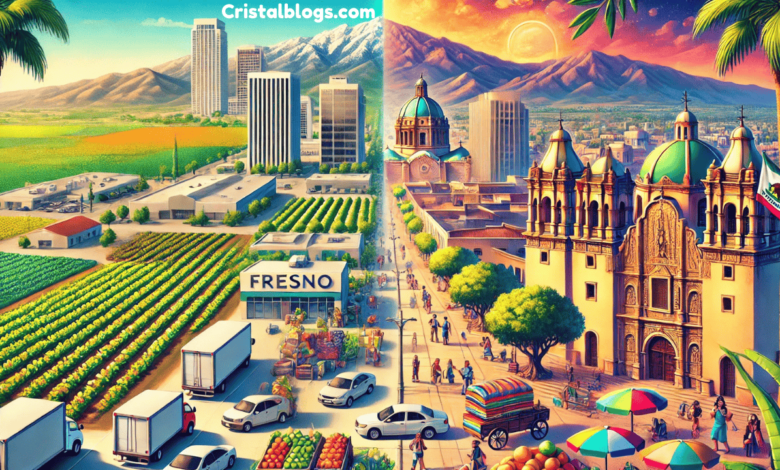Fresno vs Oaxaca City Comparison: A Tale of Two Unique Destinations

Fresno, California, and Oaxaca City, Mexico, are fascinating locations offering different living experiences. While Fresno thrives as a central hub in California’s agricultural heartland, Oaxaca City is celebrated for its vibrant culture, culinary excellence, and historical significance. This article delves into a detailed comparison of Fresno and Oaxaca City, covering climate, culture, economy, lifestyle, healthcare, and more to help you understand the unique appeal of each city.
Climate: Sunshine vs. Year-Round Comfort
Fresno is renowned for its hot, dry summers and mild winters. During the peak summer, temperatures often exceed 100°F (38°C), while cooler temperatures and occasional rainfall characterize winters. However, Fresno’s location in California’s Central Valley means it frequently experiences air pollution, particularly in the summer and winter, which can impact residents’ quality of life.
In contrast, Oaxaca City boasts a more temperate climate that many would describe as idyllic. Temperatures generally range between 60°F and 80°F (15°C to 27°C) throughout the year. The city’s higher elevation contributes to its cleaner air and milder weather. While Oaxaca experiences a rainy season from June to October, rainfall is typically short-lived, allowing for plenty of sunny days.
Cultural Richness: A Celebration of Diversity and Heritage
Fresno’s Multicultural Mosaic
Its diverse population and agricultural roots shape Fresno’s culture. The city has vibrant communities, including Hispanic, Asian, and African American groups. This diversity is reflected in local events like the Big Fresno Fair, the Armenian Festival, and the Hmong New Year celebrations. Fresno also features several cultural institutions, such as the Fresno Art Museum and Tower Theatre, which provide spaces for contemporary art and live performances.
Oaxaca’s Historical and Indigenous Heritage
Oaxaca City is often regarded as Mexico’s cultural capital. As a UNESCO World Heritage site, it deeply unites indigenous traditions and colonial history. Celebrations like the Guelaguetza Festival showcase indigenous music, dance, and vibrant costumes, while the city’s Day of the Dead festivities draw visitors worldwide. The bustling markets in Oaxaca are filled with traditional crafts, from intricate textiles to colorful alebrijes, making the city a haven for art and culture enthusiasts.
Culinary Delights: Diverse Flavors vs. a Food Lover’s Paradise
Its multicultural population and agricultural prowess heavily influence Fresno’s culinary scene. Local restaurants offer a variety of cuisines, including Mexican, Vietnamese, Chinese, and Armenian dishes. The city’s proximity to fertile farmland ensures fresh produce year-round, making it a favorite for farm-to-table dining.
On the other hand, Oaxaca City is renowned as Mexico’s culinary capital. Signature dishes like mole (a complex sauce with seven varieties) and tlayudas (giant crispy tortillas with toppings) highlight the region’s rich culinary traditions. Oaxaca is also renowned for its mezcal production, a distilled alcoholic beverage made from agave. Street food vendors and markets offer tamales, memelas, and other local delicacies, providing a culinary adventure at every corner.
Economic Landscape: Agriculture vs. Tourism
Fresno’s Agricultural Stronghold
Fresno’s economy is deeply rooted in agriculture. As a key player in California’s agricultural output, the city produces many crops, including grapes, almonds, and citrus fruits. In addition to farming, Fresno has a growing presence in sectors like healthcare, education, and renewable energy. As a distribution hub for companies like Amazon and UPS, it supports the city’s economic stability.
Oaxaca’s Tourism and Artisanal Economy
Oaxaca City’s economy thrives on tourism, fueled by its rich cultural heritage, historical landmarks, and lively festivals. Artisanal crafts and traditional agriculture also play a significant role in the local economy. The city attracts visitors eager to explore its vibrant markets, colonial architecture, and archaeological sites like Monte Albán. While the job market is smaller than Fresno, tourism and craft industry opportunities abound.
Lifestyle and Recreation: Suburban Comfort vs. Vibrant Community Life
Fresno’s Suburban Appeal
Life in Fresno offers a suburban environment with access to urban amenities. The cost of living in the city is relatively cheap compared to larger California cities like Los Angeles or San Francisco. Residents enjoy outdoor activities in nearby national parks, including Yosemite and Sequoia. Fresno’s nightlife is modest, focusing on local music venues and casual dining.
Oaxaca’s Communal Charm
Oaxaca City’s lifestyle is defined by its walkable streets, community-centered activities, and slower pace of life. The historic city center creates a charming atmosphere with its cobblestone streets and colonial buildings. Social life revolves around markets, festivals, and cultural celebrations, making it easy for expats and locals to immerse themselves in the vibrant community. The lower cost of living adds to Oaxaca’s appeal, particularly for retirees and remote workers.
Healthcare and Education: Accessibility vs. Affordability
Fresno offers a robust healthcare system with modern hospitals and specialized care facilities. Institutions like the Community Regional Medical Center ensure access to high-quality medical services. The city also boasts a strong education system, with California State University, Fresno, and numerous public and private schools.
Oaxaca City’s healthcare system is a mix of public and private services. While public healthcare is affordable, private clinics offer more personalized care at reasonable rates compared to the U.S. However, advanced medical treatments may require travel to larger cities. Education in Oaxaca focuses on preserving indigenous languages and traditions, with universities like Universidad Autónoma Benito Juárez offering courses that reflect the region’s cultural heritage.
Transportation: Cars vs. Cobblestone Streets
Fresno is a car-dependent city with an extensive network of roads and highways. While the city has a public bus system, it’s less comprehensive than those in larger urban centers. Most inhabitants rely on personal vehicles for daily commuting.
Oaxaca City, in contrast, is highly walkable, especially in its historic center. Public transportation alternatives include buses and shared taxis called “colectivos,” which are affordable and efficient. The city’s cobblestone streets add charm but can pose challenges for cyclists.
Outdoor Activities: Parks vs. Mountains
Fresno is near some of the most iconic natural attractions in the U.S., such as Yosemite National Park and Sequoia National Park. These destinations provide opportunities for hiking, camping, and wildlife observation. The city itself features several parks and recreational areas, like Woodward Park.
Oaxaca City is surrounded by rugged mountains and valleys, making it ideal for eco-tourism. Popular activities include hiking, mountain biking, and exploring nearby waterfalls. Visitors can also discover archaeological sites like Monte Albán, which offer breathtaking views and historical insights.
Safety and Security
Fresno’s crime rates are higher than the national average, with safety varying by neighborhood. While generally safe, Oaxaca City advises caution in certain areas, especially for tourists. Both cities benefit from strong community ties that enhance the sense of security.
Conclusion: Two Cities, Endless Possibilities
Fresno and Oaxaca City each offer unique advantages depending on your preferences and priorities. Fresno appeals to those seeking suburban comfort, job opportunities in agriculture or technology, and proximity to iconic natural parks. On the other hand, Oaxaca City attracts individuals drawn to cultural immersion, culinary adventures, and a laid-back lifestyle at a lower cost.




